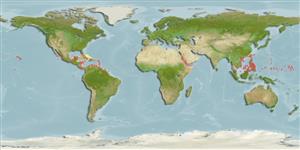Gastropoda |
Anaspidea |
Notarchidae
Environment: milieu / climate zone / depth range / distribution range
Ecology
Benthic; depth range 2 - 8 m (Ref. 108348). Subtropical; 25°N - 4°N, 88°E - 51°E (Ref. 83435)
Indo-Pacific and Western Atlantic: South Africa, the Mascarenes to Japan across to the Sea of Cortez, Mexico.
Length at first maturity / Size / Weight / Age
Maturity: Lm ? range ? - ? cm Max length : 6.5 cm TL male/unsexed; (Ref. 822)
Assumed maximum length from Ref. 822. Crawls around rocky areas and walls with good algae coverage (Ref. 822); found in sheltered pools and estuaries (Ref. 866). Lives and feeds on the blue-green algae Lyngbya majuscula (Ref. 108716).
Life cycle and mating behavior
Maturity | Reproduction | Spawning | Eggs | Fecundity | Larvae
Members of the order Anaspidea are mostly simultaneous hermaphrodites.
Debelius, H. 2001 Nudibranchs and sea snails: Indo-Pacific field guide. Unterwasserarchiv, IKAN, frankfurt, Germany, 3rd ed. 321 pp. (Ref. 844)
IUCN Red List Status
(Ref. 130435: Version 2025-1)
CITES status (Ref. 108899)
Not Evaluated
Not Evaluated
Threat to humans
Harmless
Human uses
| FishSource |
Tools
More information
Population dynamicsGrowth
Max. ages / sizes
Length-weight rel.
Length-length rel.
Length-frequencies
Mass conversion
Abundance
Life cycleReproductionMaturityFecunditySpawningEggsEgg developmentLarvae PhysiologyOxygen consumption
Human RelatedStamps, coins, misc.
Internet sources
Estimates based on models
Preferred temperature
(Ref.
115969): 25.1 - 29, mean 28.3 (based on 586 cells).
Fishing Vulnerability
Low vulnerability (10 of 100).
Price category
Unknown.
